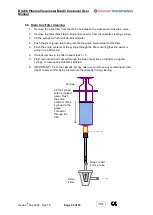
BV200 Plasma Viscometer Mk2/3 Customer User
Manual
Issue 9
th
Sep 2020 - Rev 1.8
Page 50 of 53
9.
Reagents and Samples
All calibration fluids are supplied by Benson Viscometers Ltd. and should be stored out of direct
sunlight in the laboratory at ambient room temperature.
9.1. Check Control
12 dip units per Sarstedt 2.7 tube (contains glycerine and Sodium Azide -
Toxic
)
Shelf life: 1 year from fill date - the expiry date is shown on the box and on the tube.
9.2. Check Calibrator
12 dip units per Sarstedt 2.7 tube (contains glycerine and Sodium Azide -
Toxic
)
Shelf life: 1 year from fill date - the expiry date is shown on the box and on the tube.
9.3. Low Calibration
6 dip units per Sarstedt 2.7 tube (contains glycerine and Sodium Azide -
Toxic
)
Shelf life: 1 year from fill date - the expiry date is shown on the box and on the tube.
9.4. High Calibration
6 dip units per Sarstedt 2.7 tube (contains glycerine and Sodium Azide -
Toxic
)
Shelf life: 1 year from fill date - the expiry date is shown on the box and on the tube.
9.5. Control 2.5
6 dip units per Sarstedt 2.7 tube (contains glycerine and Sodium Azide -
Toxic
)
Shelf life: 1 year from fill date - the expiry date is shown on the box and on the tube.
9.6. Control 4.0
6 dip units per Sarstedt 2.7 tube (contains glycerine and Sodium Azide -
Toxic
)
Shelf life: 1 year from fill date - the expiry date is shown on the box and on the tube.
Caution
:
Sodium Azide is toxic, however the percentage contained within the above reagents is
small (0.02%).
On disposal of any excess calibration and control fluids, flush down your allocated disposal area
with water.
9.7. Sample storage.
It is recommended to store samples intended for clinical viscosity analysis at ambient room
temperature (15-20°C) and do not to refrigerate them. The reason for this is due to the
potential for cryoproteins and or cryofibrinogen to precipitate out when the sample becomes
cold. Once precipitated cryoproteins frequently do not resuspend and are consequently not
sampled by the viscometer leading to an incorrect low result being reported.




































